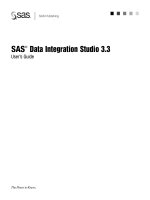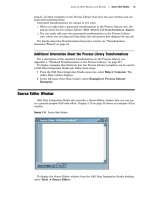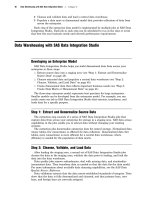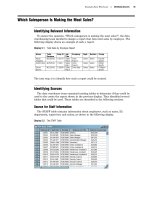SAS Data Integration Studio 3.3- P45 potx
Bạn đang xem bản rút gọn của tài liệu. Xem và tải ngay bản đầy đủ của tài liệu tại đây (511.58 KB, 5 trang )
Customizing or Replacing Generated Code in SAS Data Integration Studio Specifying Options for Transformations 225
Specifying Options in the Code Generation Tab
In SAS Data Integration Studio 3.3, you can specify options on the Code Generation
tab in the general Options window. Use this method to affect the code that is generated
for all new jobs. Many of these settings are used for parallel processing and grid
computing.
To display the general Options window from the SAS Data Integration Studio
desktop, select
Tools
Options from the menu bar. For a description of the available
options, see the Help for the tab.
Adding SAS Code to the Pre and Post Processing Tab
You can add SAS code on the
Pre and Post Processing
tab in the properties
window for a job. To display the properties window for a job, right-click the icon for the
job in the Inventory tree and select
Properties from the pop-up window. Use this
method to execute SAS code at the beginning or end of a job. For details about the
steps for adding code, see the Help for the tab. See also “(Optional) Reduce the Amount
of Data Processed by the Job” on page 153.
To redirect the SAS log and SAS output to specific locations, you could add this code
on the
Pre and Post Processing
tab:
PROC PRINTTO LOG=’’
PRINT=’’;
RUN;
You can also specify option statements for options such as FULLSTIMER,
MSGLEVEL, SYMBOLGEN, UBUFNO, WORKTERM, BLKSIZE and BUFSIZE if you
want these options to apply to an entire job.
By default, SAS Data Integration Studio specifies the MPRINT option at the start of
the code that is generated for all jobs (before any pre-processing code). The MPRINT
option adds messages to the log that are useful for debugging in a development
environment. To turn off the default MPRINT option for a particular job, add the
following code to the
Pre and Post Processing
tab:
OPTIONS NOMPRINT;
See also “Redirecting SAS Data Integration Studio’s Log to a File” on page 191.
Specifying Options for Transformations
You can specify SAS system options, SAS statement options, or
transformation-specific options on the
Options tab or other tabs in the properties
window for many transformations. Use this method to take advantage of these options
when a particular transformation executes.
Follow these steps to display the properties window for a transformation in a job:
1 Open the job to display its process flow.
2 Right-click the transformation and select Properties from the pop-up menu.
For a description of the available options for a particular transformation, see the
Help for the
Options tab or other tabs that enable you to specify options.
If the
Options tab includes a system options field, you can specify options such as
UBUFNO for the current transformation. Some transformations enable you to specify
226 Replacing the Generated Code for a Transformation with User-Written Code Appendix 2
options that are specific to that transformation. For example, the Options
tab for the
Sort transformation has specific fields for sort size and sort sequence. It also has a
PROC
SORT Options
field where you can specify sort-related options that are not otherwise
surfaced in the interface. For example, you could use these fields to specify the options
that are described in the “Sorting” section.
In addition to the
Options tab, some transformations have other tabs that enable
you to specify options that affect performance. For example, the properties window for
the SAS Scalable Performance Server Loader transformation has an Other SPD
Server Settings
tab, which enables you to specify several SAS Scalable Performance
Server options.
Replacing the Generated Code for a Transformation with User-Written
Code
You can replace the generated code for a transformation with user-written code. For
example, you can edit the code that is generated for a transformation, save it, and then
set the transformation so that the customized code runs whenever the transformation is
executed. You can switch back to have SAS regenerate the step’s code at any time. (The
edited version persists, but it is ignored.) Column mappings between the edited step
and its predecessor and successor steps remain intact.
You can use this method when you find that a transformation does not yet provide all
choices that you need in the point-and-click interface and the provided option fields. For
example, you could use this method to change the default join order that is generated for
the SQL Join transformation, as described in the section “Join Order and Performance.”
The following steps assume that a process flow has already been created, that you
know what modifications you want to make in the generated code for a particular
transformation in the flow, and that the flow displays in the Process Editor.
1 In the Process Editor, right-click the desired transformation and then select
Process
View Step Code. Code is generated for the transformation and
displays in the Source Editor window.
2
In the Source Editor window, edit the generated code.
3 When finished, click the
X in the upper right corner of the Source Editor.
4 Select
Yes to save your changes. A file selection window displays.
5 From the file selection window, specify a path name for the edited code, and click
Save. The edited code is saved to a file.
After you have save the customized code, the next task is to set the transformation so
that the customized code runs whenever the transformation is executed. Follow these
steps:
1 In the Process Designer window, select the transformation and then select File
Properties from the menu bar. The properties window for the transformation
displays.
2 Click the Process tab.
3 On the Process tab, select the User Written button. The Type field and related
fields become active.
4 In the Type field, select File.
5 Typically, you should accept the default host in the Host field.
Customizing or Replacing Generated Code in SAS Data Integration Studio Adding a User-Written Code Transformation 227
6 In the Path
field, specify a path to the file that contains the edited code. The
server in the
Host
field must be able to resolve this path. You can enter this path
or use the
Browse button to display a file-selection window.
7
After specifying the path, click
OK
to save your changes.
The specified user-written code is retrieved whenever code for this transformation is
generated. From that point forward, the edited code is used in the job code generation
(until you re-select the
Automatically create source code
option on the
Process
tab). For more details about specifying user-written code for a transformation, see the
topic “Specifying User-Written Source Code for a Transformation Within a Job” in the
Help for SAS Data Integration Studio.
Adding a User-Written Code Transformation to the Process Flow for a
Job
To create a process flow for a job, you can drag and drop transformations from the
Process Library tree into the Process Editor. If the predefined transformations in the
Process Library tree do not meet your needs for a step in a specific job, you can write a
SAS program that performs the desired task, add a User-Written Code transformation
to the process flow, and then specify the location of the new code in the metadata for the
User-Written Code transformation.
After the transformation has been inserted, you update its metadata so that it
specifies the location of your user-written code. When the job is executed, the
user-written code is retrieved and executed as part of the job.
You can base your SAS program on code that is generated for one or more standard
transformations in SAS Data Integration Studio, or you can use some other SAS
code-generation tool such as SAS Enterprise Guide to help build the initial code.
The following steps assume that you have already created a process flow, that you
have already written and tested the desired SAS program, that you are ready to add
the User-Written Code transformation to the flow, and that the flow displays in the
Process Editor.
1 Drag a User-Written Code transformation from the Process Library and drop it
into the appropriate location in the process flow.
2
Right-click the icon for the User-Written Code transformation and select
Properties from the pop-up menu.
3 On the
Source tab, either paste the revised code as metadata or specify the path to
the saved code (if you plan to maintain user-written code in an external location).
4 Make any final edits of the code; be sure the input and/or output table names are
correct. Use &SYSLAST if the input is to refer to the output from the predecessor
step, and specify &_OUTPUT as your output table name if your output is a single
work dataset being used to feed the successor step.
5 Manually define columns on the
Mapping tab if other steps are to follow. Use the
Quick Propagate option on the Mapping
tab and apply further edits to define the
output columns correctly.
When SAS Data Integration Studio generates all code for a job, it can automatically
generate the metadata for column mappings between sources and targets. However,
when you specify user-written code for part of a job, you might have to manually define
the column metadata for that part of the job that the user-written code handles. SAS
Data Integration Studio needs this metadata to generate the code for the part of the job
that comes after the user-written code step.
228 Adding a Generated Transformation to the Process Library Appendix 2
Note: In a process flow, a User-Written Code transformation can have only one
input and one output. If you need additional inputs or outputs, consider adding a
generated transformation, as described in the next section.
For more details about using a User-Written Code transformation in a job, see
“Example: Include a User-Written Code Template in a Job” in the Help for SAS Data
Integration Studio.
Adding a Generated Transformation to the Process Library
If have custom code that you would want to use in more than one place, or if there
are multiple inputs or outputs for your custom code segment, use the Transformation
Generator wizard to create a generated transformation.
To display the Transformation Generator wizard from the SAS Data Integration
Studio desk top, select
Tools
Transformation Generator from the menu bar. In the
wizard, specify the number of inputs and outputs, any custom options, then attach your
user-written SAS code, just as you would for the User-Written transformation described
in the previous section. The newly created transformation appears in the Process
Library tree, where it is available for use in any SAS Data Integration Studio job.
Drop the generated transformation into the process flow for a job and set any options.
When the job is executed, the user-written code is retrieved and executed as part of the
job. For more information, see “Maintaining Generated Transformations” on page 75.
229
APPENDIX
3
Recommended Reading
Recommended Reading
229
Recommended Reading
Here is the recommended reading list for this title:
Cody’s Data Cleaning Techniques Using SAS Software
Communications Access Methods for SAS/CONNECT and SAS/SHARE
Moving and Accessing SAS Files
PROC SQL: Beyond the Basics Using SAS
SAS Intelligence Platform: Administration Guide
SAS Intelligence Platform: Installation Guide
SAS Intelligence Platform: Overview
SAS Intelligence Platform: Security Administration Guide
SAS Management Console: User’s Guide
SAS OLAP Server: Administrator’s Guide
SAS SQL Procedure User’s Guide
For a complete list of SAS publications, see the current SAS Publishing Catalog.To
order the most current publications or to receive a free copy of the catalog, contact a
SAS representative at
SAS Publishing Sales
SAS Campus Drive
Cary, NC 27513
Telephone: (800) 727-3228*
Fax: (919) 677-8166
E-mail:
Web address: support.sas.com/pubs
* For other SAS Institute business, call (919) 677-8000.
Customers outside the United States should contact their local SAS office.









